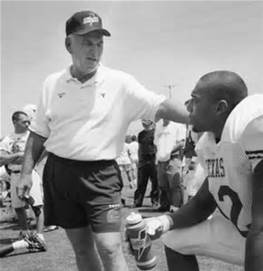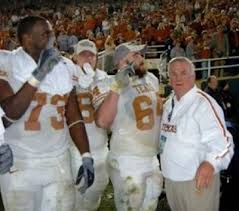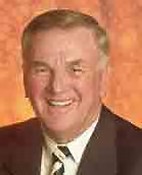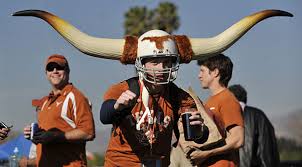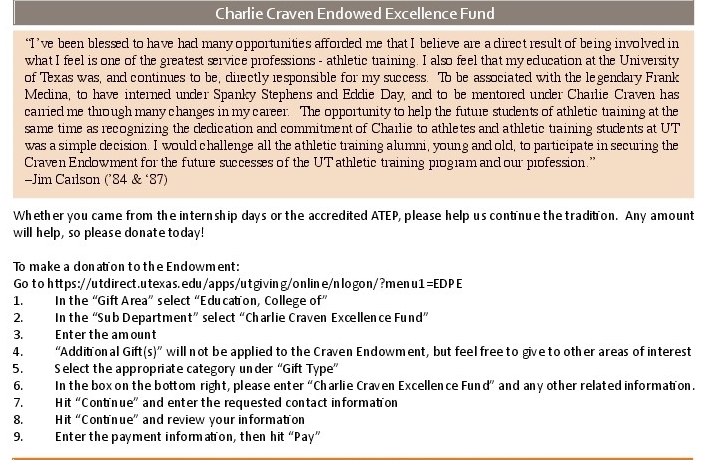To add depth to the History And Evolution Of Conditioning And Weight Lifting for the Longhorns, some content and photos from the Stark Center site are used on the TLSN site.
One of the Stark Centers directives is to study Kinesology's effect on athletes and sports. If you want more information about the Stark Center, Please visit the Stark Center at 403 East 23rd Street North End Zone, Suite 5.700 Austin, TX 78712. their Phone # is 512-471-4890, or you can visit their site at http://www.starkcenter.org
08.24.2011
Craven’s Mends the soul and strengthens the body 1964-2014
In 1964 after finishing his master’s, Craven was hired by UT as a full-time instructor for the Men’s Physical Training Program. In addition, Craven was the strength coach for all men’s athletics.
Because Royal was not an advocate of weight lifting, the players used weight vest programs, jump and reach, jump rope, boxing, and cardio drills to enhance the player’s abilities. But, according to Craven, it takes years for UT coaches to grasp the importance of weight training. Cravens said “. . . Coaches were very fearful... youngsters were going to become muscle-bound.”
Royal says: “I never cared how much they could bench-press- I never cared how much they could lift-because I was going to judge them on how well they played football, not on how well they lifted weights…. It’s a game of mobility. As long as they keep the field the length it is and the width it is, somebody’s gonna have to run and play it.”
By 1970 all the longhorn coaches started to re-think the importance of weight lifting and sought guidance from Charles Cravens. Finally, coach Royal said to Craven, “OK. We’re going to keep the training program, but I don’t want them to work too much, get too ‘taut,’ get too big.” “Now, some of the coaches didn’t like that idea, but Coach Royal liked the idea,” said Craven. “He liked something new, but he wasn’t ready to embrace it fully.”
Blessed by Royal’s new directive, Charles was the right person at the right time in Longhorn sports history to promote weight lifting. As a result, the Longhorn coaches slowly started to understand that weight training can enhance athletic performance, not hurt performance.
1973- the year weight lifting at Texas changed forever
Longhorn weight lifting changed forever in 1973. Jay Arnold says, “We were part of the ‘old school’ when it came to physical and strength training.” “We would lift and condition in the spring and off-season but put the weights away during the season.
On the other hand, Oklahoma lifted weights all year long. We changed our weight lifting protocols after that game and never looked back. We were in an era of enlightened transition as far as that was concerned.”
Craven was UT’s representative at the first meeting of the National Strength and Conditioning Association in 1978 in Lincoln, Nebraska. However, after Medina’s retirement, He shifted his duties with Athletics into rehabilitation, where he is still involved, even after retiring from the Department of Kinesiology and Health Education in 2008.
Charlie Craven patience finally overcomes the reluctance of Texas Coaches to utilize the new training techniques available for conditioning, endurance, and strength.
On Aug. 24, 2011 Nick Youngblood wrote and article about Charlie Craven for Texas Media Relations.
The Article says
Charlie Craven has earned the respect and affection of thousands of student-athletes during his more than 40 years working with UT Athletics. That adoration is still quite evident in the training room as everyone who enters makes a point to seek out Craven and say "Hey, Doc."
Craven's living legacy is the tens of thousands of athletes who are now healthier, better prepared, and better cared for as they compete on fields and courts across the country. Craven is responsible for the modern strength and conditioning program at The University of Texas, and he has had a profound impact on the development of other collegiate, professional and high school training programs as well.
He first began studying Kinesiology because he "wanted to coach and be in the sports field, and strength training was just beginning to blossom," said Craven, who was just granted an honorary membership into the National Athletic Trainers' Association.
Craven's in-class and on-field assessments exposed a "flawed" sports medicine philosophy. "Most schools used salt tablets and didn't allow water-breaks." Those practices were unacceptable to Craven, and his first chance to create change came in 1963 as the coach of the Del Valle high school football team. There, Craven made the rules. "Players had water any time they wanted it, organized breaks, and weren't given salt tablets," Craven said.
Traditionalist rejected weight lifting as a form of conditioning until late In DKR’s years as head coach.
Despite evidence that weight lifting could help an athletes performance, now advocated weight training. In fact, all coaches across the country rejected weight lifting . Terry Todd wrote in 1993:
“But even with such examples as (wrestler) Hammond, plus occasional hints from Bellmont and McLean, the other coaches at U.T. were reluctant to employ weight training as a conditioning aid. So thoroughly convinced were they and their coaching brethren throughout the U.S. that lifting would make a man tight and clumsy that any successes enjoyed by weight-trained athletes were summarily dismissed as exceptions which proved the rule. The reasons for this wrongheaded attitude are too complicated to explain in this article, but it was certainly true that throughout the first half of the 20th century, weight training was disapproved of by almost all coaches and physical educators.”
“...In football, for instance, it was thought almost unmanly to do too much preparation for fall practice. “Hell, fall practice was preparation,” was the way Bully Gilstrap, a former Texas player and coach, put it.
“Most of the old boys on the team came off the farm like I did and we were in pretty good shape from hauling hay, chopping cotton, cutting wood, and milking, but the only running I did back then was to race somebody or to try and catch one of them old jackrabbits. You got to remember how different things were then. Hell, I won the state track meet running barefoot.
By the time Gilstrap came back to U.T. in 1937, everybody did have shoes, but preseason conditioning for any varsity sport was still almost non-existent. “Things were about the same in ‘37,” he said, “‘cept we had a training table so they wouldn’t none of ‘em have to go through school on chili like I did. But all we did to warm up and all was a few jumping jacks. Then we’d run plays or scrimmage. It was pretty much the same in basketball and track, too. The boys scrimmaged in basketball and they practiced their events in track. That was it. I don’t know what they done in baseball.”
As far as baseball is concerned, the words of the late Bibb Falk are instructive. Falk played at Texas for three years, beginning in 1917, then went straight to the big leagues where he played for 12 seasons. He returned to Austin in 1932, served as assistant coach until 1940, then coached the Texas team until 1968. “We did a little of what we called P.T. in the early days, but only when it rained. Other than that the boys ran and threw and played. We wanted long, loose muscles and the word back then was that lifting would tie you up. To be honest I never even heard of a ballplayer using weights. Not in college and not in the bigs. . . . The key to baseball is power and power comes from speed and we were leery of anything that might slow us up. When I played and for most of my coaching career we always believed that if a man ran enough and threw enough he’d be strong enough.
(To read more click here)
Simple changes such as these were met with resistance from traditionalists in the world of sports, but Craven persisted. Only two years later he began a non-mandatory strength and conditioning program and a small rehabilitation program for the football program at The University of Texas under head coach Darrell K. Royal. Craven did most of his on work clearing a room and bringing in training equipment he found while visiting medical conferences around America.
After only two years and a national championship, Royal decided to continue and expand Craven's program. To Craven, it wasn't the success of the football team that fueled him. "It was the joy of starting to see our guys returning (from injury) ... something that had never happened before," Craven said. "There was nothing more rewarding to me than seeing a guy whose career and whose hopes had been just totally dashed come back and succeed."
After almost 50 years of work, Craven's influence on the world of sports medicine and sports are indelible. Thanks in part to his work, all schools including public high schools and universities must now have certified athletic trainers on staff and on site, and the conditions student-athletes play under are no longer the "Spartan" unhealthy ways they once were.
17e15b1f89e79be0e93b7a45bea87211
Craven continues his work for UT Athletics as a rehabilitation specialist, and dedication and kindness remain his trademark traits.
"I'd be the happiest guy in Texas if I was still coaching high school sports. I love the kids, and seeing young people come in at one level then go out at another," Craven said. "Can't put a price on it."
A portion of an article written about Charlie Craven's Weight Training program is below. The whole article can be read on the Stark Center site @
http://www.starkcenter.org/
During most of the 1960's the programs used by the football teams at Texas were primarily circuit programs in which “an athlete would work as hard as he could for thirty seconds, and then he had fifteen seconds to change to the next station and go as many as he could for another thirty seconds.”
One player who made a big difference in the acceptance of weight training by both coaches and other players was Tommy Nobis. According to Craven, Nobis was a great natural athlete—but he was also a really hard worker in the weight room.
As Craven recalls, “At that particular time in our history, we were concerned with shoulder and neck injuries and Tommy wanted his neck to be stronger than everyone’s. According to Craven, they fixed a special station for him so he could specifically train his neck, and, “when the other athletes saw Tommy doing that, and they watched him play, that helped create our interest in strength training a lot.”
While Craven has retired from Kinesiology, he has not retired from the Athletics Department where he still works with the football team overseeing injury rehabilitation. According to Jeff Madden, Assistant Athletic Director for Strength and Conditioning, Craven plays an invaluable role on that team.
“He’s the glue that holds us together,” said Madden. “He’s been an inspiring person, an incredible role model for the athletes, and I’ve watched him bring player after player back into shape after their injuries. He’s one of the most impressive and honorable men I’ve met in coaching, and it’s been a real honor for me to work with him all these years.”
When asked to think back on that earlier time, Craven said, “It was just so much fun to see those youngsters improve, even though it was through circuit training and we couldn’t get the pure strength, as we know it today, but they did get absolutely stronger and never entered a game, back in that time, where we thought the fourth quarter would be anyone’s business but the University of Texas at Austin. We took over. I get a lot of satisfaction out of seeing the strength and conditioning program today compared to where it was when I started. To tell you the basic difference, I tell you, back in that time, as I’ve said in earlier comments, I had the entire offense for one hour and the entire defense for one hour. I could not take into account the individual differences, individual needs by position, because that was the only time that Coach Royal would allow. Since I was working at his pleasure, I certainly followed his directions. So, that was the first model. Just circuit training. Now, we have every program and every sport is individualized to where every youngster has records on computers and we have normal progressions, periodization concepts, and all of this. We have taken science to a real new height in the strength and conditioning programs in America. We have done that here too at the University of Texas.”
The Charlie Craven Endowed Excellence Fund — combining the best of academics and athletics
Can’t decide between supporting UT academics and athletics? You can do both with a single gift. A proposed Endowed Excellence Fund in the highly ranked Kinesiology and Health Education Department in the College of Education would honor Charlie Craven, a rehabilitation specialist and former associate professor whose UT legacy combines the best of academics and athletics.
Proceeds from the Charlie Craven Endowed Excellence Fund support faculty and programming in athletic training, helping ensure that students are learning in the highest-quality classrooms and labs.

